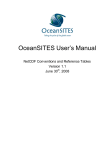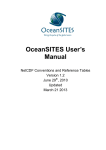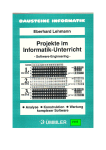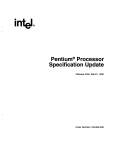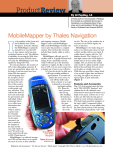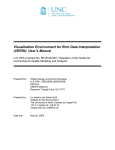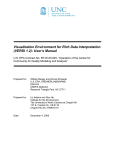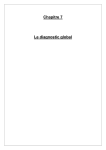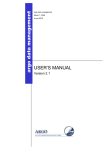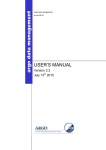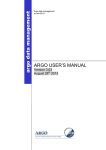Download OceanSITES User's Manual
Transcript
March 26th, 2008 Supprimé : May 2nd, 2006 cordo/dti-mut/03-034 OceanSITES User’s Manual Version 1.1 Supprimé : 0 OceanSITES User’s Manual Ref : cordo/dti-mut/03-034 Version : 1.1 Date : 26/03/2008 Authors : • OceanSITES data management team Supprimé : 0 Supprimé : 02/05/2006 3 Table of contents HISTORY 4 1. OVERVIEW 5 2. OCEANSITES DATA FORMAT 7 2.1. 2.2. 2.3. 2.4. DATA FILE DIMENSIONS GLOBAL ATTRIBUTES GENERAL ATTRIBUTES, META-DATA INFORMATIONS MEASUREMENTS 7 8 11 13 3. OCEANSITES META -DATA FORMAT 15 4. REFERENCE TABLES 16 4.1. REFERENCE TABLE 1 : DATA TYPE AND DATA CODE 4.1.1. D ATA TYPE 4.1.2. D ATA CODE 4.2. REFERENCE TABLE 2 : QUALITY CONTROL FLAG SCALE 4.2.1. REFERENCE TABLE 2.1: QUALITY CONTROL LEVEL INDICATOR 4.3. REFERENCE TABLE 3 : OCEANSITES PARAMETER DICTIONARY 4.4. REFERENCE TABLE 4: DATA ASSEMBLY CENTER C ODES 16 16 16 16 17 18 20 5. FILE NAMING CONVENTION 21 5.1. DATA FILE NAMING CONVENTION 5.2. METADATA FILE NAMING CONVENTION 21 21 OceanSITES User Manual 27/03/2008 4 History Version 0.1 0.2 0.3 Date 20/03/2003 10/12/2003 20/02/2004 0.3.2 0.4 0.5 0.6 0.7 0.7 0.7 0.8 26/05/2004 01/06/2004 21/06/2004 28/06/2004 09/02/2005 23/05/2005 24/05/2005 11/10/2005 0.8 01/02/2006 1.0 18/02/2006 Comment TC : creation of the document TC : general update for Argo trajectory 2.1 compatibility TC : updates on locations, mooring name, data state indicator, parameters table, epic codes, history information N.G.: make more flexible, add dataset (metadata) file TC : separate data set description and data file TC : merge with Steve Hankins's strawman TC : updates from Nan Galbraith, Steve Hankins, Jonathan Gregory, Brian Eaton YI : updates on attributes Maureen Edwards : NOCS data centre, new GF3 parameters Roy Lowry : physical parameters from BODC Data Markup Vocabulary TC : remove latitude and longitude dimension. <PARAM> dimension is TIME instead of (TIME, LATITUDE, LONGITUDE) TC : update of reference table 3 parameter codes NG : reference table 2.1 parameter quality control indicator added TC : §5 file naming convention added TC : updates following OceanSITES data management meeting 2006, Hawai’I §2.1 : LEVEL dimension replaces DEPTH to accomadate depth or pressure §2.2 : QC_MANUAL field created §2.2 : CONVENTION field removed §2.2 : PLATFORM_CODE added §2.2 : SITE_CODE added §2.2 : WMO_PLATFORM_CODE added §2.3 : DEPTH renamed DEPH to comply to GF3 §2.3 : DATA_MODE set at measurement level §3 : metadata file description transfered to “OceanSITES meta-data proposal” until approval §5 : file naming convention updated 1.0 1.0 1.0 1.1 19/02/2006 28/04/2006 28/04/2006 April 2008 OceanSITES User Manual NG : data codes in chapter 4.1.2 PF & NG : data mode optional TC & JG : §2.2 global attributes TC : general revision for OceanSites 2008 meeting 27/03/2008 5 1. Overview The objective is to define both a common format for data exchange within the proje ct and to identify the minimal metadata content for data to be exchanged. The format is built on the community-supported Climate and Forecast standard NetCDF implementation which supplies a standard vocabulary and some metadata conventions that we adopt. For each data set : • A unique name for moorings comprising the dataset • data center name • contact person : person in charge of the dataset • date of last update of the data set • list of available parameters • list of files comprising the dataset • overall dates, overall location(s) For each file: • unique address for each mooring : WMO code or unique name • data center name • contact person : person in charge of the data in the file • data centre : centre which processed the data file • date of last update or creation of the data in this file • list of parameters • technical parameters • overall dates, overall location(s) • number of dimensions • type of timebase (original, averaged, gridded) • file containing source data, if appropriate For each parameter : • sampling method description • data processing level • list of instruments and sensors • calibration equation if applicable • parameter unit • technical parameters OceanSITES User Manual 27/03/2008 6 For each measurement : • date and time (UTC) • measured parameter • historical parameters • QC OceanSITES User Manual 27/03/2008 7 2. OceanSITES data format An OceanSITES data file contains measurements such as temperature, salinity, continuously performed at different levels on a platform (eg : mooring), as well as meteorological or other parameters recorded at the site, derived variables associated with the site, and complete location and time information. The requirements are drawn almost exclusively from the netCDF Style Guide : • Dimension names are not standardized so that optionally multiple variables with different coordinates can be combined in a single file ; • Variable names are not standardized, so that multiple variables containing the same physical quantity can be contained in a single file ; • Units are compliant with CF/COARDS/Udunits ; • Time is encoded as recommended by Unidata and used by COARDS, CF and others. Mis en forme : Barré For more information on CF and COARDS see : • http://cf-pcmdi.llnl.gov/ • http://www.ferret.noaa.gov/noaa_coop/coop_cdf_profile.html. Supprimé : http://www.cgd.ucar .edu/cms/eaton/cf- metadata/CF1.0.html 2.1. Data file dimensions Name TIME Definition TIME= unlimited; Comment Number of recorded measurements of the file. LEVEL LEVEL=<int value>; Number of depth levels on the mooring. Example : For a mooring with measurements at 10, 50, 100, 150, 200 meters LEVEL = 5 STRING256 STRING64 STRING32 STRING8 STRING5 STRING4 STRING2 DATE_TIME STRING64 = 256; String dimensions. STRING64 = 64; STRING32 = 32; STRING8 = 8; STRING4 = 5; STRING4 = 4; STRING4 = 2; DATE_TIME = 14; Supprimé : STRING14 If necessary, additional dimensions can be used in OceanSITES files, as defined in the CF standard. For instance, to indicate that different measured parameters are associated with different depth arrays, dimensions LEVEL and LEVEL_2 may be specified. Data from instruments at different locations may be combined in a single file using additional location dimensions, LATITUDE, LONGITUDE and LATITUDE_2, LONGITUDE_2. OceanSITES User Manual 27/03/2008 8 2.2. Global attributes The global attribute section is dedicated to metadata. It is intended to provide information mainly for the benefit of human readers. It is organized in 5 sections : • What : what are the data in this dataset ; • Where : the spatial coverage of the data ; • When : the temporal coverage of the data ; • Who : who produced the data ; • How : how where produced the data , how are they available . The global attributes follows the recommendations of Unidata NetCDF Attribute Convention for Dataset Discovery : http://www.unidata.ucar.edu/software/netcdfjava/formats/DataDiscoveryAttConvention.html#cdm_data_type_Attribute The title, institution, source, history, references and comment global attributes are necessary follow the CF-1.1 convention. Name WHAT title institution source history references comment conventions netcdf_version date_creation OceanSITES User Manual Value Mis en forme : Police :Italique, Non Surlignage Mis en forme : Police :Italique, Non Surlignage Mis en forme : Police :Italique Definition :title="OceanSITES CIS in-situ data"; A succinct description of what is in the dataset. The "title" attribute gives a brief description of the dataset. It should be human readable and reasonable to display in a list of such names. e.g. : “OceanSITES ESTOC in-situ data” :institution="Nationa Specifies where the original data was produced. l Oceanographic Data provider name Centre"; :source="ocean inThe method of production of the original data. If it was model-generated, source situ observation" should name the model and its version, as specifically as could be useful. If it is observational, source should characterize it (e.g., "surface observation" or "radiosonde"). :history="2005-04Provides an audit trail for modifications to the original data. Well-behaved generic 11 08:35:00Z data netCDF filters will collected"; automatically append their name and the parameters with which t hey were invoked to the global history attribute of an input netCDF file. We recommend that each line begin with a timestamp indicating the date and time of day that the program was executed. The "history" attribute provides an audit trail for modifications to the original data. It should contain a separate line for each modification with each line including a timestamp, user name, modification name, and modification arguments. TC : use iso8601 for all the string dates ? :references=http:// Published or web-based references that describe the data or methods used to produce www.nocs.uk; it. References that describe the data or the methods used to produce it. Include here the names of configuration files that have been used as well as selected configuration parameters :comment="…" Miscellaneous information about the data or methods used to produce it. The "comment" attribute allows for miscellaneous information about the dataset. Use of this attribute is recommended as appropriate. :conventions="CF Name of the conventions followed by the dataset. 1.1"; e.g. : "CF -1.1" :netcdf_version=3.5 Netcdf version used for the data set :date_creation="200 File creation date (UT) 6-04- 11 08:35:00Z"; in the form “yyyy-mm-dd hh:mm:ss UT” (Year-Month-Day -Hour-Minute-second) TC : use iso8601 for all the string dates ? 27/03/2008 Mis en forme : Police :Italique Mis en forme : Police :Italique Supprimé : 0 Supprimé : UT Mis en forme : Police :Italique Supprimé : 18xx 9 summary naming_authority keywords_vocabulary :summary=”…”; The "summary" attribute gives a longer description of the dataset. Its use is highly recommended. In many discovery systems, the title and the summary will be displayed in the results list from a search. It should therefore capture the essence of the dataset it describes. For instance, we recommend this field include information on the type of data contained in the dataset, how the data was created (e.g., instrument X; or model X, run Y), the creator of the dataset, the project for which the data was created, the geospatial coverage of the data, and the temporal coverage of the data. This should just be a summary of this information, more detail should be provided in the recommended creator attributes, the recommended geospatial attributes, and the recommended temporal attributes. :naming_authority=” The "id" and "naming_authority" attributes are intended to provide a globally unique OceanSITES” identification for each dataset. The "id" value should attempt to uniquely identify the :id=” OS_CISdataset. The naming authority allows a further refinement of the "id". The combination 1_200502_TS » of the two should be globally unique for all time. We recommend using reverse-DNS naming for the naming authority. For example, naming_authority="edu.ucar.unidata" and id="NCEP/NAM_211_2005-05- 24_12Z". : The "keywords_vocab ulary" attribute identifies the controlled list of keywords from keywords_vocabular which the values in the "keywords" attribute are taken. If you are following a y=”…” guideline for the words/phrases in your "keywords" attribute, put the name of that guideline here. The use of this attribute is recommended and its value will be used by THREDDS to identify the vocabulary from which the keywords come. Common values for the "keywords_vocabulary" attribute include: Vocabulary ID "AGU Index Terms" "GCMD Science Keywords" cdm_data_type data_mode WHERE area southernmost_latitude northernmost_latitude westernmost_longitude easternmost_longi tude minimum_depth maximum_depth sensor_depth latitude longitude WHEN start_date stop_date WHO Institution institution_references OceanSITES User Manual : cdm_data_type=”St ation” :data_mode=’D’ Reference URL http://www.agu.org/pubs/indexterms/ http://gcmd.gsfc.nasa.gov/Resources/valids/gc md_parameters.html The "cdm_data_type" attribute gives the THREDDS data type appropriate for this dataset. E.g. "Point", "Trajectory ", "Station", "Radial ", "Grid", "Swath". CDM : common data model from Unidata. More : http://www.unidata.ucar.edu/projects/THREDDS/CDM/CDM-TDS.htm Indicates if the file contains real time or delayed mode data. R : real time data D : delayed mode data M : mixed real -time and delayed mode data :area="Western Europe"; :southernmost_latitu de="35"; :northernmost_latitu de="55"; :westernmost_longit ude="-11°"; :easternmost longitude="14°"; : minimum_depth ="10.0"; : maximum_depth ="2000.0"; :sensor_depth=”0,2 0,50,75,100,500” :latitude="0.0" :longitude="-10" Geographical coverage e.g.: Global Ocean, North Atlantic Ocean, North- West European shelves Value between - 90° and 90° :start_date="2006 03-01 00:00:00Z"; Start date of the data in UT in the form “yyyy-mm-dd hh:mm:ss UT” (Year-Month-Day -Hour-Minute-second) TC : use iso8601 for all the string dates ? Final date of the data in UT in the form “yyyy-mm-dd hh:mm:ss UT” (Year-Month-Day -Hour-Minute-second) TC : use iso8601 for all the string dates ? :stop_date="200603-05 23:59:29Z"; :institution="Southa mpton National Oceanographic Cebtre"; :institution_referenc Supprimé : , Supprimé : Grid Supprimé : Image Supprimé : Station Supprimé : Trajectory Supprimé : Radial Supprimé : Time- series Value between - 90° and 90° Supprimé : float Value between - 180° and 180° Value between - 180° and 180° Minimum depth for measurements Maximum depth for measurements Nominal depth of each sensor or level Nominal latitude of a site Nominal longitude of a site Supprimé : UT Mis en forme : Police :Italique Mis en forme : Police :Italique Data provider name References for data provider, the place to find all information upon the data set 27/03/2008 10 contact author HOW distribution_statement quality_index OceanSITES User Manual es="http://www.nocs (Web-based) .uk"; :contact="codac@n User desk e-mail ocs.uk"; :author= "John Name of the person responsible for the creation of the dataset. Smith" :distribution_statem ent="Data restrictions: for registered users only "; :quality_index="A"; Supprimé : C Mis en forme : Anglais (Royaume-Uni) Text like “Approved for public release. Distribution unlimited” or "Data restrictions: for registered users only" or better to link to the place where the rule is described Supprimé : A code value valid for the whole dataset : 0 unknown quality A excellent (no known problems, regular quality checking) B probably good (occasional problems, validation phase) C extremely suspect, frequent problems 27/03/2008 11 2.3. General attributes, meta -data informations The general attributes are a subset of the meta-data file. The general attributes are of character type. Do we get rid of section 2.3 "General attributes" and move these items in global attributes? I think that the global attributes section is for human readers "only". If some information needs to be processed by software, don't you think that it is better to appear as a variable in the "General attributes section"? Variables moved in global attributes section: QC_MANUAL DISTRIBUTION_STATEMENT: already in global attributes CITATION DATE_CREATION DATE_UPDATE DATE_SOURCE PROJECT_NAME PI_NAME DATA_CENTRE DATA_TYPE FORMAT_VERSION Variables that could remain in "General attributes" PLATFORM_CODE SITE_CODE WMO_PLATFORM_CODE Name DATA_TYPE FORMAT_VERSION QC_MANUAL DATE_CREATION DATE_UPDATE DATE_SOURCE OceanSITES User Manual Definition char DATA_TYPE(STRING32); DATA_TYPE:long_name = "Data type"; DATA_TYPE:_FillValue = " "; char FORMAT_VERSION(STRING4); FORMAT_VERSION:long_name = "File format version"; FORMAT_VERSION:_FillValue = " "; Char QC_MANUAL (STRING64); QC_MANUAL:long_name = "Quality control manual reference"; QC_MANUAL:_FillValue = " "; char DATE_CREATION(DATE_TIME); DATE_CREATION:long_name = "Date of file creation"; DATE_CREATION:conventions = "YYYYMMDDHHMISS"; DATE_CREATION:_FillValue = " "; char DATE_UPDATE(DATE_TIME); DATE_UPDATE:long_name = "Date of update of this file"; DATE_UPDATE:conventions = "YYYYMMDDHHMISS"; DATE_UPDATE:_FillValue = " "; char DATE_ SOURCE (DATE_TIME); DATE_ SOURCE:long_name = "Date of source of this file"; DATE_ SOURCE:conventions = "YYYYMMDDHHMISS"; DATE_ SOURCE:_FillValue = " "; Comment This field contains the type of data contained in the file. The list of acceptable data types is in the reference table 1. Example : “OceanSITES data” File format version Example : «1.0» This field contains the name of the manual that describes the quality contrl procedure. Exemple : “OceanSITES quality control manual V1.0” Date and time (UTC) of creation of this file. Format : YYYYMMDDHHMISS Example : 20011229161700 : December 29th 2001 16:17:00 TC : use iso8601 for all the string dates ? Date and time (UTC) of update of this file. Format : YYYYMMDDHHMISS Example : 20031230161700 : December 30th 2001 16:17:00 TC : use iso8601 for all the string dates ? Date and time (UTC) of source of this file. Format : YYYYMMDDHHMISS This is the date of the original file that may come from an other project (eg : Woce) Example : 19850529161700 : May 5th 1985 16:17:00 TC : use iso8601 for all the string dates ? 27/03/2008 Supprimé : comment Supprimé : comment Supprimé : comment Supprimé : comment Mis en forme : Police :Italique Supprimé : C Mis en forme : Police :Italique Supprimé : C Mis en forme : Police :Italique 12 DISTRIBUTION_STATE MENT CITATION PLATFORM_CODE SITE_CODE WMO_PLATFORM_CO DE PROJECT_NAME PI_NAME DATA_CENTRE OceanSITES User Manual char DISTRIBUTION_STATEMENT(STRING64); DISTRIBUTION_STATEMENT:long_name = " Restriction on use for these data"; DISTRIBUTION_STATEMENT:_FillValue = " "; char CITATION (STRING256); CITATION:long_name = "T his sentence should be used for publication"; CITATION:_FillValue = " "; char PLATFORM_CODE(STRING32); PLATFORM_CODE:long_name = "Platform unique identifier"; PLATFORM_CODE:conventions = "OceanSITES naming convention"; PLATFORM_CODE:_FillValue = " "; char SITE_CODE(STRING32); SITE_CODE:long_name = "Site unique identifier"; SITE_CODE:conventions = "OceanSITES naming convention"; SITE_CODE:_FillValue = " "; char WMO_PLATFORM_CODE(STRING5); WMO_PLATFORM_CODE:long_name = "WMO code"; WMO_PLATFORM_CODE:conventions = "WMO naming convention : A84II"; WMO_PLATFORM_CODE:_FillValue = " "; char PROJECT_NAME(STRING64): PROJECT_NAME:long_name = "Name of the project"; PROJECT_NAME:_FillValue = " "; char PI_NAME (STRING64); PI_NAME:long_name = "Name of the principal investigator"; PI_NAME:_FillValue = " "; char DATA_CENTRE(STRING2); DATA_CENTRE:long_name = "Data centre in charge of data processing"; DATA_CENTRE:conventions = "OceanSites reference table 4"; DATA_CENTRE:_FillValue = " "; Restriction on use for these data. Example : "NONE" Supprimé : DATA_RESTRICT IONS Supprimé : C The citation should be used for publications. Example : "These data were collected and made freely available by the International OceanSITES Project and the national programmes that contribute to it." Platform unique code within OceanSITES project. Examples : CIS-1 mooring on CIS site (Central Irminger Sea). PIRATA-LAMBADA for Lambada buoy from PIRATA project. Supprimé : DATA_RESTRICT IONS Name of the site within OceanSITES project. Exam ple : CIS for Central Irminger Sea. LAMBADA for Pirata Lambada site. Supprimé : comment Supprimé : DATA_RESTRICT IONS Supprimé : comment Supprimé : DATA_RESTRICT ION S Supprimé : C Supprimé : Restriction on use for t Supprimé : ese data WMO identifier for a mooring. WMO is the World Meteorological Organization. This platform number is unique within OceanSITES project. Example : 13009 for PIRATA -LAMBADA buoy. Supprimé : C Name of the project which operates the mooring. Example : PIRATA Supprimé : Float Supprimé : C Supprimé : C Name of the principal investigator in charge of the mooring. Example : Jacques SERVAIN Supprimé : comment Code for the data centre in charge of the mooring data management. The data centre codes are described in the reference table 4. Example : ME for MEDS Supprimé : float 27/03/2008 Supprimé : Argo 13 2.4. Measurements This section contains measurements performed on a platform (eg : mooring). The “axis” attribute provides an unambiguous mechanism to orient a coordinate variable in 4space. Name TIME TIME_QC LATITUDE if applicable LONGITUDE if applicable POSITION_QC DEPH PRES DEPH_QC PRES_QC <PARAM> OceanSITES User Manual Definition Double TIME(TIME); TIME:long_name = "days since 1950-01-01 00:00:00"; TIME:standard_name = "time"; TIME:units = "days since 1950-01-01 00:00:00"; TIME:conventions = "Relative julian days with decimal part (as parts of the day)"; TIME:axis = "T"; TIME:_FillValue = 999999.; TIME:epic_code = 601.; Byte TIME_QC(TIME); TIME_QC:long_name = “quality flag”; TIME_QC:conventions = “OceanSITES reference table 2”; TIME_QC:_FillValue = 0; Float LATITUDE(TIME); LATITUDE:long_name = "Latitude of each location"; LATITUDE:standard_name = "latitude"; LATITUDE:units = "degree_north"; LATITUDE:_FillValue = 99999.f; LATITUDE:valid_min = -90.f; LATITUDE:valid_max = 90.f; LATITUDE:epic_code = 500; LATITUDE:axis=’Y’; Float LONGITUDE(TIME); LONGITUDE:long_name = "Longitude of each location"; LONGITUDE:standard_name = "longitude"; LONGITUDE:units = "degree_east"; LONGITUDE:_FillValue = 99999.f; LONGITUDE:valid_min = -180.f; LONGITUDE:valid_max = 180.f; LONGITUDE:epic_code = 501; LONGITUDE:axis=’X’; Byte POSITION_QC(TIME); POSITION_QC:long_name = “quality flag”; POSITION_QC:conventions = “OceanSITES reference table 2”; POSITION_QC:_FillValue = 0; Float DEPH (LEVEL); DEPH:long_name = "Depth of each measurement"; DEPH:standard_name = "depth"; DEPH:units = "meter"; DEPH:positive = "down"; DEPH:axis="z"; DEPH:_FillValue = - 99999.f; DEPH:valid_min = 0.f; DEPH:valid_max = 12000.f; DEPH:epic_code =; Comment Julian day of the measurement. The integer part represents the day, the decimal part represents the time of the measurement. Date and time are in universal time coordinate. Example : 18833.8013889885 : July 25 2001 19:14:00 Byte DEPH _QC(TIME); DEPH _QC:long_name = “quality flag”; DEPH _QC:conventions = “OceanSITES reference table 2”; DEPH _QC:_FillValue = 0; Float <PARAM>(TIME, LEVEL); <PARAM>:long_name = "<Y>"; <PARAM>:standard_name = "<X>"; <PARAM>:units = "<Y>"; <PARAM>:_FillValue = <Y>; <PARAM>:QC_indicator = <Z>; <PARAM>:valid_min = <Y>; <PARAM>:valid_max = <Y>; <PARAM>:comment = "<Y>"; Quality flag applied on each DEPH values. The flag scale is specified in table 2. Supprimé : Supprimé : UTC Supprimé : UTC Quality flag applied on each TIME values. The flag scale is specified in table 2. Latitude of the mooring. This variable is mandatory for single point observations. Unit : degree north Example : 44.4991 for 44° 29’ 56.76’’ N Longitude of the mooring. This variable is mandatory for single point observations. Unit : degree east Example : 16.7222 for 16° 43’ 19.92’’ E Supprimé : optional Supprimé : optional Supprimé : ; the nominal latitude is included in the global attributes section Supprimé : optional Supprimé : optional; the nominal longitude is included in the global attributes section Quality flag applied on each LATITUDE and LONGITUDEvalues. The flag scale is specified in table 2. Supprimé : T Depth of each measurement. Unit : meter In case of pressure use PRES U nit : decibar Example : 513 meters Z axes may be positive=”UP” (atmospheric) or positive=”DOWN” (ocean) <PARAM> contains the values of a parameter The name of the parameter starts with a parameter code listed in reference table 3. Example of <PARAM> names : TEMP, TEMP_DOXY <X> : the standard name of the parameter is specified in the reference table 3. <Y> : this fields are platform dependant. 27/03/2008 14 <PARAM>_QC <PARAM>_DATA_MODE optional <PARAM>:ancillary_variables = "<Y>" ; <PARAM>:resolution = <Y>; <PARAM>:epic_code = <Y>; Byte <PARAM>_QC(TIME, LEVEL); <PARAM>_QC:long_name = “quality flag”; <PARAM>_QC:conventions = “OceanSITES reference table 2”; <PARAM>_QC:_FillValue = 0; Char <PARAM>_DATA_MODE(TIME, LEVEL); <PARAM>_DATA_MODE:long_name = "Delayed mode or real time data"; <PARAM>_DATA_MODE:conventions = "R : real time; D : delayed mode"; <PARAM>_DATA_MODE:_FillValue = " "; <Z> : the quality control indicator is specified in table 2.1 Quality flag applied on each <PARAM> values. The flag scale is specified in table 2. This variable is opti onal. It is included when the dataset mixes real -time data and delayed mode data. Otherwise, it is located at the global attributes level. Indicates if the file contains real time or delayed mode data. R : real time data D : delayed mode data Different depth or pressure levels If for some measurements it is more natural to use depth (DEPH, e.g. velocities from an ADCP), while for others it is better to use pressure (PRES, e.g. from MicroCat sensors on the mooring line), the data should be recorded in separate files. Suggestion from Matthias Lankhorst : If PRES is used, DEPH should be provided as nominal values or as a simplified function of PRES and LATITUDE (Unesco 1983. Algorithms for computation of fundamental properties of seawater, 1983. Unesco Tech. Pap. in Mar. Sci., No. 44, 53 pp.)." Supprimé : If the d epth or pressure from different instruments on a same mooringmismatch, they should be recorded in separate files. ¶ Example : on an ADCP the velocity is record ed at fixed depths, while a temperature sensor fixed on the mooring line moves up and down at variable depths. These ADCP data and temperature data should be recorded in separate files.¶ Supprimé : Question : should we keep EPIC codes ? ¶ OceanSITES User Manual 27/03/2008 15 3. OceanSITES meta-data format Can we decide that the global attributes section of data format contains the meta-data ? The Ocean sites meta-data format is under construction. The data management team is investigating an XML SENSORML description. When approved, this document will be inserted in chapter 3 “OceanSITES meta-data format” of the User’s Manual. Note that the OceanSITES format already contains a subset of meta-data. An OceanSITES meta-data file contains information about an OceanSITES platform configuration. For each deployment of a mooring, a meta-data file is created. For each change in a mooring characteristics, a meta-data file is created. OceanSITES User Manual 27/03/2008 16 4. Reference tables 4.1. Reference table 1 : data type and data code 4.1.1. Data Type The following table contains the list of acceptable contents for DATA_TYPE field. Data type OceanSITES data OceanSITES meta-data 4.1.2. Data code Data codes are used for file naming convention in chapter 5.1. • T : temperature • S : salinity • C : conductivity • O : oxygen • M : meteorological parameters • V : velocity 4.2. Reference table 2 : quality control flag scale This table describes quality control flags assigned to measurements after quality control. These codes are used in the <PARAM>_QC variables that accompany each measurement, cf. section 2.4." Code 0 1 Meaning No QC was performed Good data Real-time comment All real-time QC tests passed. Delayed mode comment - 2 Probably good data - - 3 Bad data that are potentially correctable These data are not to be used without scientific correction. - 4 Bad data Data have failed one or more of the tests. - 5 Value changed - 6 7 Not used Nominal value ? Data may be recovered after transmission error. Data were not observed but OceanSITES User Manual - Supprimé : Not used 27/03/2008 17 8 Interpolated value 9 Missing value reported ? Missing data may be interpolated from neighbouring data in space or time. - ... [1] Mise en forme : Puces et numéros 4.2.1. Reference table 2.1: quality control level indicator This table describes the quality procedures applied to all the measurement of a parameter. These values are used as an overall quality indicator (i.e. one summarizing all measurements) in the attributes of each variable <PARAM>, cf. section 2.4. Code Meaning 0 No QC performed 1 Ranges applied, bad data flagged 2 Data interpolated 3 Sensor malfunctioning (data possibly useful) 4 data missing (which is different from sensors malfunctioning) 5 data manually reviewed 6 data verified against model or other contextual information 7 other QC process applied OceanSITES User Manual 27/03/2008 18 4.3. Reference table 3 : OceanSITES parameter dictionary Convention for parameter names, standard names and units • Parameter names They are not strictly standardized, so that multiple variables containing the same physical quantity can be contained in a single file. However, the parameter names are based in part on the group codes of the GF3 dictionnary (4 characters). When necessary, a parameter name has a suffix that designates secondary parameters1 . The suffix starts with the character “_”. • The NetCDF “standard_name” attribute contains the standardized parameter name, based in part on CF conventions. • The NetCDF “units” attribute are compliant with CF/COARDS/Udunits. Supprimé : a parameter name have Example On a mooring, sea temperature measured by a series of Microcat CTD is reported as TEMP, with a standard name of SEA_WATER_TEMPERATURE. Secondary temperature measurements 1 performed by an oxygen sensor is reported as TEMP_DOXY with a standard name of SEA_WATER_TEMPERATURE. For both measurement, the unit attribute is “degree_Celsius”. References The OceanSITES parameter names are bas ed partly on GF3 group codes available at : • ftp://ftp.pol.ac.uk/pub/bodc/jgofs/datadict/new/parameter.csv Associated to each parameter name, the standard_name is based partly on CF conventions available at : • http://cf-pcmdi.llnl.gov/documents/cf-standard-names/7/cf-standard-name-table.html The units are compliants with CF/COARDS/Udunits definition available at : • http://ferret.wrc.noaa.gov/noaa_coop/coop_cdf_profile.html Supprimé : http://www.oceansit es.org/data/units 1 A secondary parameter is an additional measurement performed by a sensor not specifically decicated to this parameter (eg : a temperature from an oxygen sensor, a temperature from a thermosalinograph). OceanSITES User Manual Supprimé : <#>http://www.cgd. ucar.edu/mailman/listinfo/cfmetadata¶ http://www.cgd.ucar.edu/cms/eato n/cf-metadata/CF-1.0.html 27/03/2008 19 Valid parameter names and standard names The valid parameter names, standard names, long_names and units are available at : • http://www.ifremer.fr/co/etc/oceansites/oceansites -user-manual-parameters.pdf Supprimé : ¶ PARAM OceanSITES User Manual 27/03/2008 ... [2] 20 4.4. Reference table 4: Data Assembly Center Codes Data centres and institutions BO BODC, United Kingdom IF Ifremer, France JA Jamstec, Japan JM JMA, Japan ME MEDS, Canada NO National Oceanography Centre, Southampton PM PMEL, USA SI SIO, Scripps, USA WH Woods Hole Oceanographic Institution, USA GT GTS : used for data coming from WMO GTS network OceanSITES User Manual 27/03/2008 21 5. File naming convention Supprimé : conventions : The OceanSITES files comply with the following naming conventions: 5.1. Data file naming convention OS_XXX_YYY_ZZZ<_PARTX>.nc • OS : OceanSITES prefix • XXX : platform code • YYY : configuration code • ZZZ : data type code from reference table 1 The data type code is the addition of the primary (main) parameters measured in a file. The data type code will not list secondary parameters. • <_PARTX> : when an OceanSites data file size becomes excessive (eg : > 100Mb), it can be splitted in smaller parts : PART1, PART2, … PARTN Example : • OS_CIS-1_200502_TS.nc This file contains the CTD data from CIS mooring, from Animate project, for the deployment performed in February 2005. Note that the data start in February until the next re-deployment. Supprimé : ¶ 5.2. Metadata file naming convention Do we remove this section if meta-data are reported in the global attributes of data files ? OS_XXX_YYY_META.xml • OS : OceanSITES prefix • XXX : platform code • YYY : configuration code Example : • OS_CIS-1_200502_META.nc This file contains the meta-data of CIS mooring, from Animate project, for the deployment performed in February 2005. These meta-data are valid from February 2005 until the next re-deployment. OceanSITES User Manual 27/03/2008 Page 17: [1] Supprimé tmsi-idm-isi 22/03/2008 23:10:00 Page 19: [2] Supprimé isi 25/03/2008 18:34:00 PARAM Standard Name CNDC SEA_WATER_ELECTRICAL_CONDUCTIVITY PRES SEA_WATER_PRESSURE DEPH DEPTH PSAL SEA_WATER_SALINITY TEMP SEA_WATER_TEMPERATURE RELH RELATIVE_HUMIDITY ATMP AIR_TEMPERATURE ATMOSPHERIC PRESSURE EWSB WIND_SPEED CAPH AIR_PRESSURE SWR SURFACE_DOWNWELLING_SHORTWAVE_FLUX_IN_AIR LWR SURFACE_DOWNWELLING_LONGWAVE_FLUX_IN_AIR RFVL SEA_WATER_SPEED DOXY DISSOLVED_OXYGEN FLU2 FLUORESCENCE OPBS OPTICAL_BACKSCATTERING_COEFFICIENT PCO2 CARBON_DIOXIDE Parameters awaiting definition PARAM Standard Name ???? ???? DIRECTION_OF_SEA_WATER_VELOCI TY THICKNESS_OF_RAINFALL_AMOUNT ???? RAINFALL_RATE long_name unit comment convention Spectrally derived average height of the highest onethird of the waves during the sampling period Spectrally derived average wave period of all waves WMO -No. 702 Gu Wave Analysis an Forecasting 1998 ????WSP WIND_SPEED D ????WDI WIND_TO_DIRECTION R ???? EASTWARD_WIND ???? NORTHWARD_WIND ???? PHOTOSYNTHETICALLY_ACTIVE_RADI ATION IRRADIANCE_AT_MULTIPLE_WAVELE NGTHS RADIANCE_AT_MULTIPLE_WAVELENG THS BEAM_ATTENUATION ???? ???? ???? ???? ???? ABSORBTION_AND_ATTENUATION_C OEFFICIENT_AT MULTI_WAVELENGTHS NITRATE_ABSORBANCE ATMS SURFACE_AIR_PRESSURE DRYT air_temperature Air Temperature degree_Celsius DEWT dew_point_temperat ure Dew Point Temperature degree_Celsius SRAD isotropic_shortwave_radiance_in_air Shortwave Radiation W/m^2 VAVH sea_surface_wave_significant_height Significant Wave Height m VAVT sea_surface_wave_zero_upcrossing_peri Average Wave Period od s WMO -No. 702 Gu Wave Analysis an degrees_true Forecasting 1998 Spectral derived wave direction at the peak of the energy spectrum Energy for each frequency component VDIR sea_surface_wave_from_direction VDEN sea_surface_wave_variance_spectral_de Spectral Wave Density nsity m^2/Hz D sea_water_sigma_theta kg/m**3 - UCUR eastward_sea_water_velocity sigma-theta (potential density) zonal current WMO -No. 702 Gu Wave Analysis an Forecasting 1998 WMO -No. 702 Gu Wave Analysis an Forecasting 1998 - cm/s - - VCUR northward_sea_water_velocity meridional current cm/s - - CSPD sea_water_speed current speed cm/s - - CDIR sea_water_direction sea_water_direction deg from N - - UWND eastward_wind zonal wind m/s - - VWND northward_wind meridional wind m/s - - WSPD wind_speed wind speed m/s - - WDIR wind_to_direction deg from N - - AIRT air_temperature wind direction (oceanographic convention, blowing to) air temperature deg C - - RH relative_humidity relative humidity % - - SW W/m**2 - - W/m**2 - - RAIN surface_downwelling_shortwave_flux_in_ shortwave radiation air surface_downwelling_longwave_flux_in_ai longwave radiation r rainfall_rate rain mm/hr - - iso17 isotherm_depth 17C isotherm depth m - - dynht dynamic_height cm - - HEAT heat_content 10**10 J/m**2 - - xpos longitude dynamic height at sea surface referenced to 500db upper ocean heat content from 0 to 300m depth buoy longitude deg - - ypos latitude buoy latitude deg - - LW Wave Direction during the sampling period























